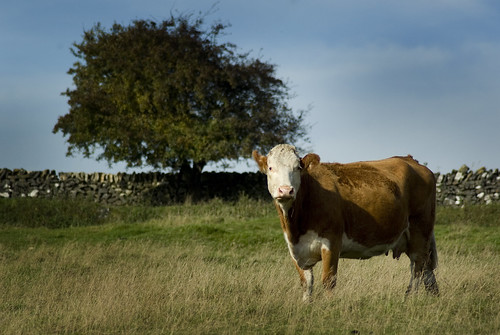The reason is pure economics. Has nothing to do with the quality of beef produced. Let me lay it out for you.
I've already covered in a broad sense how grain-finished beef is more expensive to produce than grass-fed beef.
Let's look this over:
- I don't have to have a lot of expensive equipment to run my farm or produce my crops.
- I don't have to spray anything as the cows eat almost all of the weeds.
- I don't have to deal with insects, since the more I can get in the pastures (well, except maybe face flies) the better the pastures do.
- If I do it right and manage my grazing, I don't have to even cut and bale hay for the winter.
- And If I manage my herd properly, the soil will actually improve in quality - which means I can actually start adding more cows just to keep up with the grass.
Follow the money...
What's my net cost for each calf I produce? About $40 in shots for the new ones (and I'm beginning to think those are even unnecesary...)Now, per beeffrompasturetoplate.org,
The truth is it takes 2.6 pounds of grain and 435 gallons of water to produce a pound of beef in the United States.
When you take a 400lb just-weaned calf up to 1100lbs, you are using 1820 lbs of grain (usually corn and soybeans, ground and mixed). If it were just corn and I had to buy it at commodity prices, I'd be paying at least $4 per bushel (more or less) - so a rough cost would put the extra cost at $7280 - at least on paper. Large operations will get their feed much cheaper than this (and have to.) But that tells you right there why you pay high beef prices and farmers still go broke.
My own experiences, from fattening cattle on this farm, told me that the feed bills alone took half the calf crop. We never made enough corn on our land to feed out cattle, so we'd sell the corn we raised (for real minimal profit) and then buy the other feed.
Now, the funny thing was when I found out feeder calves (sold right after weaning) made as much income as keeping those calves up to fattening weight - well, I never fattened cattle on corn again. (And I got to keep the money from that corn we raised.)
The next price break was when I found that a calf fattened to a year old on just grass will give me about $600 profit per head - and that's taking out the cost of keeping them and their mother alive during the winter with hay.
So my profit of selling these calves as yearlings was better than feeding them on corn I didn't have.
The next break - selling them as finished cattle (about 20-22 months) was no better profit, because you have to winter them over with hay again. Since they are now eating more to put those last few pounds on, it's a wash for those extra months. (Of course, when I go over to "mob grazing" and no hay in the winter - every calf is nearly sheer profit...)
The cost of Government-inspected Organic Beef
Here's where organic comes in. Annually, I would have to keep paperwork and get this inspected to prove that I didn't add anything to the land or the cattle. So I pay a fee to have my paperwork checked - for every single acre and animal (as I understand it.) Essentially, this is a government tax at work.Right now, the premium paid for locally-raised, grass-fed beef is the same or higher than organic beef. Why? Because people know where it came from and who butchered it.
And the last case of e-coli infecction I heard of came from what? USDA Government-inspected beef - which came from cattle out of four states and two countries, all mixed together into a yummy, tasteless, uniform-sized, frozen, plastic-wrapped, gray patty.
So if it costs more to get the government involved, but I make the same amount of income - which is more profitable? Pasture-finished or organic pasture-finished? (And we're leaving out the idea of making organic corn - a whole 'nother expense...)
That's why I'm not going to be raising organic beef anytime soon. It gets the government into your operation and makes it cost more. I'll make more money and higher quality beef, even if I just sell to my neighbors in our local cities.
- - - -
While I raise my own grass-fed beef here in Missouri, I suggest you try a vendor such as La Cense Beef


No comments:
Post a Comment